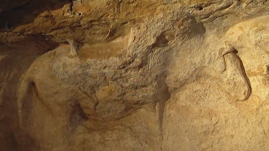Teachers' Domain - Digital Media for the Classroom and Professional Development
User: Preview

Source: The Human Spark: "Becoming Us"




Major funding for The Human Spark is provided by the National Science Foundation, and by the Alfred P. Sloan Foundation. Additional funding is provided by the John Templeton Foundation, the Cheryl and Philip Milstein Family, and The Winston Foundation.
ALAN ALDA (NARRATION) We’ve come to southwestern France, where the winding valleys of rivers like the Vézère and the Dordogne have been desirable real estate for hundreds of thousands of years.
ALAN ALDA It was under overhangs in these cliffs that the people we call Neanderthals first made their homes, here and through much of Europe for thousands of generations.
ALAN ALDA (NARRATION) I’m on my way to a rock shelter that may have housed Neanderthals at one time, but carries an enduring message from another human species – us.
ALAN ALDA The rock shelter is called Cap Blanc. Today it’s sealed behind this building because carved into it is one of the most remarkable works of art ever created.
These horses, so life-like and vibrant they seem to be springing from the rock, were carved some 15 to 20 thousand years ago. But the person who sculpted them wasn’t a Neanderthal. He or she – or maybe they – were relative newcomers to the region. And they brought with them something unprecedented in the 3 billion years of life’s evolving on this planet. It was something their Neanderthal neighbors didn’t possess. We’re calling that something the Human Spark.
ALAN ALDA (NARRATION) Just a few miles from here is the famous cave of Lascaux with its vivid paintings of ice age animals. This whole region is rich with spectacular cave art – the earliest unmistakable evidence that here were people with minds like our own. In fact, these paintings are so stunning that it’s long been assumed that it was here in Europe that the Human Spark ignited, some 30 or 40 thousand years ago. But as we’ll discover, a revolution in archeology is now pushing the first flickerings of the Spark to a much earlier time – and another continent.
 Loading Standards
Loading Standards